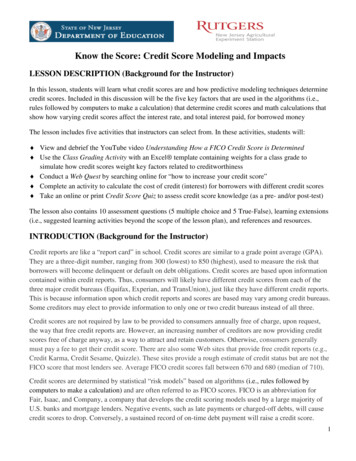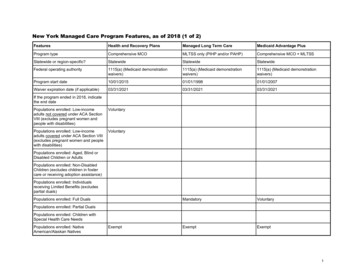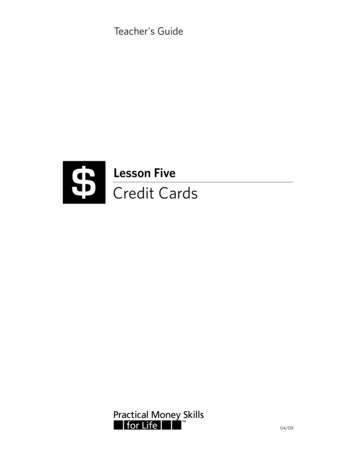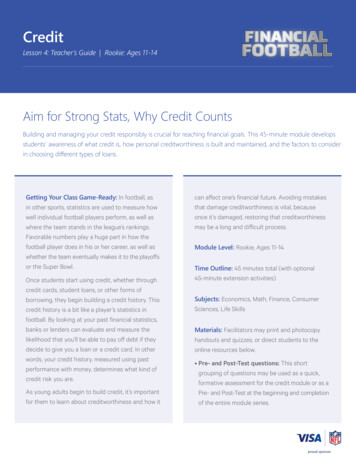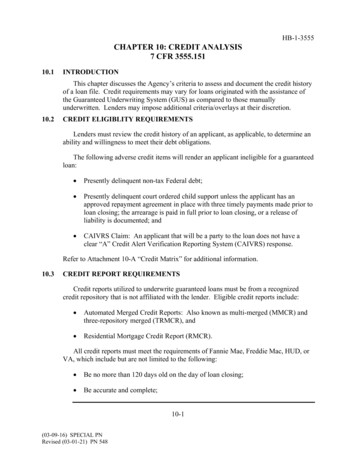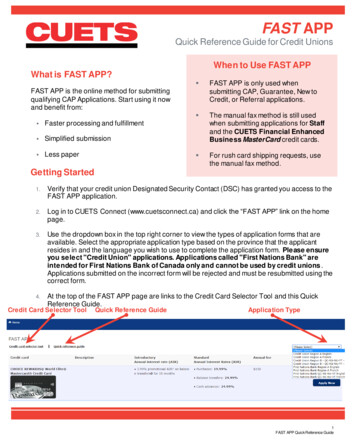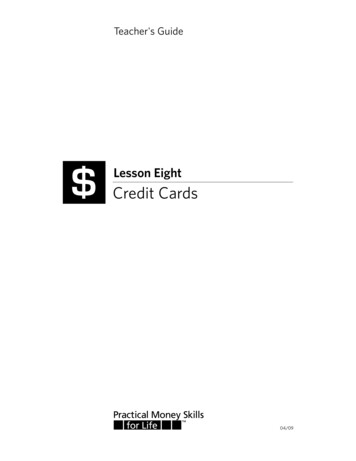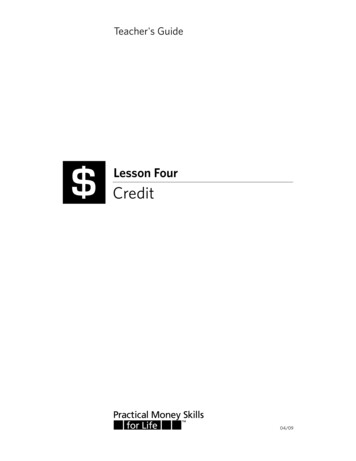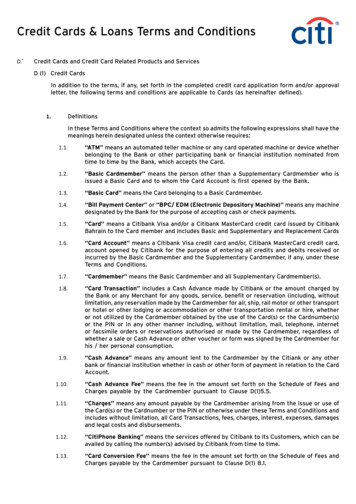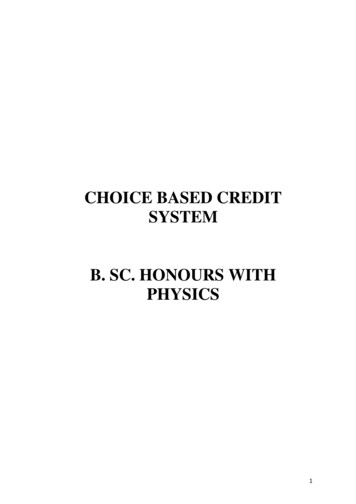
Transcription
CHOICE BASED CREDITSYSTEMB. SC. HONOURS WITHPHYSICS1
PreambleB. Sc. (Honours) in PhysicsPhysics is the most of basic of sciences. It seeks to understand natural phenomena in aquantitative manner, and to answer some of the oldest and deepest questions ever askedby human beings: What are things made of? Is there a limit to the smallest things that wecan think of? Did the world have a beginning? Will it have an end? At the same time, itprovides the base of much of the technology that we take for granted in the 21 st century:computers, artificial satellites, mobile phones, TV, microwave ovens Indeed, it will notbe an exaggeration to say that modern human life is shaped by technologies that arelargely based on a foundation of physics.Since the discipline of physics has existed for three hundred years, its „core‟ body ofknowledge is larger than that of many other branches of learning. It was, therefore,difficult to fit this knowledge into 14 core courses. Naturally, we would aim to include asmuch of basic physics as possible, while introducing the student to the applied aspects ofphysics. We also need to keep in view the role of physics as a training ground for themind. Not all students who complete B.Sc. (Hons.) in Physics will go on to becomeprofessional physicists. Nevertheless, the study of physics is likely to make them good atlogical thinking, quantitative argumentation, etc. Finally, we need to remember that thisis an era of interdisciplinary studies. The physics student will benefit by the study offields that overlap with other domains of knowledge. The syllabus presented hererepresents an attempt to balance all these requirements.Finally, a word on the Generic Electives to be chosen by physics students. They are, ofcourse, free to exercise their choice in any way that they see fit. However, for those whowish to pursue higher studies in Physics, it is recommended that they take at two coursesin Mathematics and two courses in Chemistry.2
Course Structure(Physics-Major)Details of courses under B.Sc. (Honours)Course*CreditsTheory PracticalTheory Tutorial I. Core Course(14 Papers)14X4 5614X5 70Core Course Practical / Tutorial*(14 Papers)14X2 2814X1 14II. Elective Course(8 Papers)A.1. Discipline Specific Elective(4 Papers)A.2. Discipline Specific ElectivePractical/Tutorial*(4 Papers)B.1. Generic Elective/Interdisciplinary(4 Papers)B.2. Generic ElectivePractical/ Tutorial*(4 Papers)4X4 164X5 204 X 2 84X1 44X4 164X5 204 X 2 84X1 4Optional Dissertation or project work in place of one Discipline Specific Electivepaper (6 credits) in 6th SemesterIII. Ability Enhancement Courses1. Ability Enhancement Compulsory(2 Papers of 2 credit each)Environmental ScienceEnglish/MIL Communication2 X 2 42. Ability Enhancement Elective (Skill Based)(Minimum 2)2 X 2 4(2 Papers of 2 credit each)Total credit1402 X 2 42 X 2 neralInterest/Hobby/Sports/NCC/NSS/related courses on its own.*Wherever there is a practical there will be no tutorial and vice-versa. The size ofgroup for practical papers is recommended to be maximum of 12 to 15 students.3
PROPOSED SCHEME FOR CHOICE BASED CREDIT SYSTEM INB. Sc. Honours (Physics)CORE COURSE (14)IMathematical Physics-I (4 4)IIMechanics (4 4)Electricity& Magnetism (4 4)Waves and Optics (4 4)IIIIVVVIAbilityEnhancementCompulsoryCourse (AECC) (2)AbilityEnhancementElective Course(AEEC) (2)(Skill Based)Elective:DisciplineSpecificDSE (4)Elective:Generic(GE) (4)(English/MILCommunication)/Environmental Sc.GE-1Environmental Sc./(English/MILCommunication)GE-2Mathematical Physics–II(4 4)Thermal Physics (4 4)Digital Systems &Applications(4 4)Mathematical Physics–III (4 4)Elements of Modern Physics (4 4)Analog Systems&Applications(4 4)Quantum Mechanics andApplications(4 4)Solid State Physics (4 4)AECC -1GE-3AECC -2GE-4DSE-1DSE -2Electromagnetic Theory (4 4)DSE -3Statistical Mechanics (4 4)DSE -4B. Sc. Honours (Physics)SEMESTER COURSE OPTEDIAbility Enhancement CompulsoryCourse-ICore course-ICore Course-I Practical/Tutorial*Core course-IICore Course-II Practical/Tutorial*Generic Elective -1Generic Elective -1Practical/Tutorial*IIAbility Enhancement CompulsoryCourse-IICore course-IIICOURSE NAMEEnglish/MIL communications/Environmental ScienceMathematical Physics-IMathematical Physics-I LabMechanicsMechanics LabGE-1Credits242424/52/12English/MIL communications/Environmental ScienceElectricity and Magnetism44
IIIIVVVICore Course-III Practical/Tutorial*Core course-IVCore Course-IVPractical/Tutorial*Generic Elective -2Generic Elective -2Practical/Tutorial*Core course-VCore Course-V Practical/Tutorial*Core course-VICore Course-VI Practical/Tutorial*Core course-VIICore Course-VII Practical/Tutorial*Skill Enhancement Course -1Generic Elective -3Generic Elective -3 Practical/Tutorial*Core course-VIIICourse-VIII Practical/Tutorial*Core course-IXCourse-IX Practical/Tutorial*Core course-XCourse- X Practical/Tutorial*Skill Enhancement Course -2Generic Elective -4Generic Elective-4 Practical/Tutorial*Core course-XICore Course-XI Practical/Tutorial*Core course-XIICore Course-XII Practical/Tutorial*Discipline Specific Elective -1Discipline Specific Elective -1Practical/Tutorial*Discipline Specific Elective -2Discipline Specific Elective- 2Practical/Tutorial*Core course-XIIICore Course-XIII Practical/Tutorial*Core course-XIVCore Course-XIV Practical/Tutorial*Discipline Specific Elective -3Discipline Specific Elective -3Practical/Tutorial*Discipline Specific Elective-4Discipline Specific Elective -42424/52/1Mathematical Physics-II4Mathematical Physics-II Lab2Thermal Physics4Thermal Physics Lab2Digital Systems and Applications4Digital Systems & Applications Lab 2SEC-12GE-34/52/1Mathematical Physics III4Mathematical Physics-IIILab2Elements of Modern Physics4Elements of Modern Physics Lab2Analog Systems and Applications4Analog Systems & Applications Lab 2SEC -22GE-44/52/1Quantum Mechanics & Applications 4Quantum Mechanics Lab2Solid State Physics4Solid State Physics Lab2DSE-14DSE-1 Lab2Electricity and Magnetism LabWaves and OpticsWaves and Optics LabGE-2DSE-2DSE-2 Lab42Electro-magnetic TheoryElectro-magnetic Theory LabStatistical MechanicsStatistical Mechanics LabDSE-3DSE-3 Lab424242DSE-4DSE-4 Lab425
Practical/Tutorial*TotalCredits*Wherever there is a practical there will be no tutorial and vice-versa. The size ofgroup for practical papers is recommended to be maximum of 12 to 15 students.140B.Sc. (Hons) PhysicsCore Papers (C): (Credit: 06 each) (1 period/week for tutorials or 4 periods/week for practical)1. Mathematical Physics-I (4 4)2. Mechanics (4 4)3. Electricity and Magnetism (4 4)4. Waves and Optics (4 4)5. Mathematical Physics–II (4 4)6. Thermal Physics (4 4)7. Digital Systems and Applications(4 4)8. Mathematical Physics III (4 4)9. Elements of Modern Physics (4 4)10. Analog Systems and Applications (4 4)11. Quantum Mechanics and Applications (4 4)12. Solid State Physics (4 4)13. Electromagnetic Theory (4 4)14. Statistical Mechanics (4 4)Discipline Specific Elective Papers: (Credit: 06 each) - DSE 1-4(4 papers to be selected: 02each forOdd semester and Even semesteras listed below)Odd semester:1. Experimental Techniques (4) Lab (4)2. Advanced Mathematical Physics (4) Lab (4)orLinear Algebra and Tensor analysis (5) Tutorial (1)3. Embedded systems- Introduction to Microcontroller (4) Lab (4)4. Nuclear and Particle Physics (5) Tutorial (1)5. Physics of Devices and Communication (4) Lab (4)6. Astronomy and Astrophysics (5) Tutorial (1)7. Atmospheric Physics (4) Lab (4)8. Biological physics (5) Tutorial (1)Even Semester:9. Advanced Mathematical Physics-II (5) Tutorial (1)10. Communication System (4) Lab (1)11. Applied Dynamics (4) Lab (4)12. Verilog and FPGA based system design (4) Lab (4)13. Classical Dynamics (5) Tutorial (1)14. Digital Signal processing (4 ) Lab (4)15. Nano Materials and Applications(4) Lab (4)6
16. Physics of the Earth (5) Tutorial (1)17. Medical Physics (4) Lab (4)18. Advanced Quantum Mechanics (5) Tutorial (1)19. DissertationSkill Enhancement Courses (02 to 04 papers) (Credit: 02 each)- SEC1 to SEC41. Physics Workshop Skills2. Computational Physics Skills3. Electrical circuits and Network Skills4. Basic Instrumentation Skills5. Renewable Energy and Energy harvesting6. Engineering Design and Prototyping7. Radiation Safety8. Applied Optics9. Weather Forecasting10. Introduction to Physical Computing11. Numerical --------------Generic Elective Papers (GE) (Minor-Physics) for other Departments/Disciplines:(Credit: 06 each)Odd Semesters (1st and 3rdsemesters)1. Electricity and Magnetism (4) Lab (4)2. Mathematical Physics(4) Lab (4)3. Digital, Analog and Instrumentation(4) Lab (4)4. Applied Dynamics (4) Lab (4)5. Medical Physics (4) Lab (4)6. Waves and Optics (4) Lab (4)7. Quantum Mechanics (4) Lab (4)*8. Communication System (4) Lab (4)*9. Verilog and FPGA based system design (4) Lab (4)*10. Nano Materials and Applications(4) Lab (4)**Not offered in 1st semester.Even semesters (2nd and 4th semesters)11. Mechanics (4) Lab (4)12. Elements of Modern Physics (4) Lab (4)13. Solid State Physics (4) Lab (4)14. Embedded System: Introduction to microcontroller(4) Lab (4)15. Biological physics (5) Tutorials (1)16. Thermal Physics (4) Lab (4)17. Digital Signal processing (4 ) Lab (4)18. Nuclear and Particle Physics (5) Tut (1)**19. Astronomy and Astrophysics (5) Tutorials (1)**7
20. Atmospheric Physics (4) Lab (4)**21. Physics of the Earth (5) Tutorials (1)****Not offered in 2nd semester.8
CORE COURSE (HONOURS IN --------------------------- -----------------------------Semester HYSICS-C I: MATHEMATICAL PHYSICS-I(Credits: Theory-04, Practicals-02)Theory: 60 LecturesThe emphasis of course is on applications in solving problems of interest to physicists.The students are to be examined entirely on the basis of problems, seen and unseen.Calculus:Plotting of functions. Approximation: Taylor and binomial series (statementsonly). First Order Differential equations (variable separable, homogeneous, nonhomogeneous),exact and inexact differential equations and Integrating Factor.(6 Lectures)Second Order Differential equations:Homogeneous Equations with constantcoefficients. Wronskian and general solution.Particular Integral with operator method,method of undetermined coefficients and variation method of parameters. Eulerdifferential equation and simultaneous differential equations of First and Second order.(15 Lectures)Vector Algebra:Properties of vectors. Scalar product and vector product, Scalar tripleproduct and their interpretation in terms of area and volume respectively. Scalar andVector fields.(6 Lectures)Vector Calculus:Vector Differentiation: Directional derivatives and normal derivative.Gradient of a scalar field and its geometrical interpretation.Divergence and curl of avector field.Del and Laplacian operators. Vector identities.(10 Lectures)Vector Integration: Ordinary Integrals of Vectors. Double and Triple integrals, changeof order of integration, Jacobian.Notion of infinitesimal line, surface and volumeelements.Line, surface and volume integrals of Vector fields.Flux of a vector field.Gauss' divergence theorem, Green's and Stokes Theorems and their verification (norigorous proofs).(16 Lectures)Orthogonal Curvilinear Coordinates:Orthogonal Curvilinear Coordinates. Derivation of Gradient, Divergence, Curl andLaplacian in Cartesian, Spherical and Cylindrical Coordinate Systems.(7 Lectures)Reference Books: Mathematical Methods for Physicists,G.B.Arfken, H.J.Weber, F.E.Harris,2013, 7 thEdn., Elsevier. An introduction to ordinary differential equations, E.A.Coddington, 2009, PHI learning9
Differential Equations, George F. Simmons, 2007, McGraw Hill.Advanced Engineering Mathematics,D.G.Zill and W.S.Wright, 5 Ed.,2012,Jones andBartlett Learning Mathematical Physics, Goswami, 1 st edition, Cengage Learning Engineering Mathematics, S.Pal and S.C. Bhunia, 2015, Oxford University Press Advanced Engineering Mathematics, Erwin Kreyszig, 2008, Wiley --------PHYSICS LAB-CI LAB:60 PeriodsThe aim of this Lab is not just to teach computer programming and numerical analysisbut to emphasize its role in solving problems in Physics. Highlights the use of computational methods to solve physics problems The course will consist of lectures (both theory and practical) in the Lab Evaluation to be done not on the programming but on the basis of formulating theproblem Aim at teaching students to construct the computational problem to be solved Students can use any one operating system:Linux or Microsoft Windows At least 12 programs must be attempted from the followingTopicsIntroduction and OverviewBasics of scientific computingAlgorithms and Flow chartsIntroduction to C Descriptions with ApplicationsComputer architecture and organization, memory andInput/output devices,Binary and decimal arithmetic, Floating pointnumbers, algorithms, Sequence, Selection andRepetition, single and double precision arithmetic,underflow and overflow - emphasize the importance ofmaking equations in terms of dimensionless variables,Iterative methodsPurpose, symbols and descriptionIntroduction to Programming: Algorithms: Sequence,Selection and Repetition, Structured programming,basic idea of Compilers. Data Types, Enumerated Data,Conversion & casting, constants and variables,Mathematical, Relational, Logical and BitwiseOperators. Precedence of Operators, Expressions andStatements, Scope and Visibility of Data, block, Localand Global variables, Auto, static and Externalvariables.Programs: To calculate area of a rectangle To check size of variables in bytes (Use ofsizeof() Operator)10
C Control Statementsif-statement, if-else statement, Nested if Structure,Else-if statement, Ternary operator,Goto statement,switch statement, Unconditional and Conditionallooping, While loop, Do-while loop, For loop,nestedloops, break and continue statementsPrograms: To find roots of a quadratic equation if elseAnd if else if To find largest of three numbers To check whether a number is prime or not To list Prime numbers up to 1000Random Number generatorTo find value of pi using Monte Carlo simulationsArrays and FunctionsSum and average of a list of numbers, largest of a givenlist of numbers and its location in the list, sorting ofnumbers in ascending descending order using Bubblesort and Sequential sort, Binary search,Solution of linear and quadratic equation, solvingSolution of Algebraic andTranscendental equations byBisection, Newton Raphsonand Secant methodsInterpolation by NewtonGregory Forward andBackward difference formula,Error estimation of linearinterpolationNumerical differentiation(Forward and Backwarddifference formula) andIntegration (Trapezoidal andSimpson rules), Monte CarlomethodSolution of OrdinaryDifferential Equations (ODE)First order Differentialequation Euler, modified Eulerand Runge-Kutta (RK) secondand fourth order methods sin in optics, 2 tan ; I I 0 Evaluation of trigonometric functions e.g. sin , cos ,tan etcGiven Position with equidistant time data calculatevelocity and acceleration and vice versa. Find the areaof BH Hysteresis loopFirst order differential equation Radioactive decay Current in RC, LC circuits with DC source Newton‟s law of cooling Classical equations of motionAttempt following problems using RK 4 order method: Solve the coupled differential equations𝑑𝑥𝑥 3 𝑑𝑦 𝑦 𝑥 ;𝑑𝑡3 𝑑𝑥for four initial conditions 𝑥11
x(0) 0, y(0) -1, -2, -3, -4.Plot x vs y for each of the four initial conditions onthe same screen for 0 t 15Referred Books: Introduction to Numerical Analysis, S.S. Sastry, 5 th Edn., 2012, PHI Learning Pvt. Ltd. Schaum'sOutlineofProgrammingwithC . J.Hubbard, 200 0, McGraw‐HillPub. NumericalRecipesinC :TheArtofScientificComputing,W.H.Presset.al.,2 nd Edn.,2013, CambridgeUniversityPress. An introduction to Numerical methods in C , Brian H. Flowers, 2009, OxfordUniversity Press. A first course in Numerical Methods, U.M.Ascher & C. Greif, 2012, PHI Learning. ElementaryNumericalAnalysis, K.E.Atkinson,3 r d E d n . , 2 0 0 7 , WileyIndiaEdition. Computational Physics, Darren Walker, 1 st Edn., 2015, Scientific International Pvt. --------------------------------------- ---------------------PHYSICS-C II: MECHANICS(Credits: Theory-04, Practicals-02)Theory: 60 LecturesThis course begins with the review of Newton’s Laws of Motion and ends with theFictitious Forces and Special Theory of Relativity. Students will also appreciate theCollisions in CM Frame, Gravitation, Rotational Motion and Oscillations. The emphasisof this course is to enhance the understanding of the basics of mechanics. By the end ofthis course, students should be able to solve the seen or unseen problems/numericals inmechanics.Fundamentals of Dynamics:Inertial frames; Review of Newton‟s Laws ofMotion.Momentum of variablemass system: motion of rocket. Dynamics ofa system ofparticles.Principle of conservation of momentum. Impulse.Determination of Centre ofMass of discrete and continuous objects having cylindrical and spherical symmetry (1-D,2-D & 3-D).(7 Lectures)Work and Energy: Work and Kinetic Energy Theorem. Conservative and nonconservative forces. Potential Energy. Energy diagram. Stable, unstable andneutralequilibrium. Force as gradient of potential energy. Work & Potential energy. Workdone by non-conservative forces. Law of conservation of Energy.(5 Lectures)Collisions: Elastic (1-D and 2-D) and inelastic collisions. Centre of Mass and Laboratoryframes.(4 Lectures)Rotational Dynamics: Angular momentum of a particle and system of particles. Torque.Principle of conservation of angular momentum. Rotation about a fixed axis. Moment ofinertia, theorem of parallel and perpendicular axes (statements only). Determination ofmoment of inertia of discrete and continuous objects [1-D, 2-D & 3-D (rectangular,12
cylindrical and spherical)]. Kinetic energy of rotation. Motion involving both translationand rotation.(10 Lectures)Gravitation and Central Force Motion:Law of gravitation. Gravitational potentialenergy. Inertial and gravitational mass. Potential and field due to spherical shell and solidsphere.(2 Lectures)Motion of a particle under a central force field: Two-body problem, its reduction toone-body problem and its solution. Reduction of angular momentum, kinetic energy andtotal energy. The energy equation and energy diagram. Kepler‟s Laws. Satellite incircular orbit, Geosynchronous orbits.(7 Lectures)Oscillations: Idea of SHM. Differential equation of SHM and its solution. Kineticenergy, potential energy, total energy and their time-average values.Compoundpendulum. Damped oscillation. Forced oscillations: Transient and steady states,sharpness of resonance and Quality Factor.(6 Lectures)Non-Inertial Systems: Reference frames, Galilean transformations, Galilean invariance,Inertial and Non-inertial frames and fictitious forces. Uniformly rotating frame.Centrifugal force. Coriolis force and its applications.(5 Lectures)Special Theory of Relativity: Outcomes of Michelson-Morley Experiment. Postulates ofSpecial Theory of Relativity. Lorentz Transformations. Simultaneity, Length contraction,Time dilation. Relativistic transformation of velocity, acceleration, frequency and wavenumber. Variation of mass with velocity. Massless Particles. Mass-energy Equivalence.Relativistic Doppler effect (transverse and longitudinal). Relativistic Kinematics (decayproblems, inelastic collisions and Compton effect). Transformation of Energy andMomentum.(14 Lectures)Reference Books: An Introduction to Mechanics, Daniel Kleppner& Robert Kolenkow, 2007, TataMcGrawHill Mechanics, DS Mathur, PS Hemne, 2012, S. Chand University Physics, FW Sears, MW Zemansky& HD Young 13/e, 1986,AddisonWesley Mechanics Berkeley Physics course, v.1: Charles Kittel, et.al. 2007, TataMcGrawHill Physics – Resnick, Halliday & Walker 9/e, 2010, Wiley Engineering Mechanics, Basudeb Bhattacharya, 2nd edn., 2015, Oxford UniversityPress University Physics, Ronald Lane Reese, 2003, Thomson ------------------PHYSICS LAB-C II LAB60 PeriodsAt least 06 experiments from the following13
1. Measurements of length (or diameter) using Vernier calliper, screw gauge andtravelling microscope.2. To study the random error in observations.3. To determine the height of a building using a Sextant.4. To study the motion of the spring and calculate (a) Spring constant and, (b) g.5. To determine the Moment of Inertia of a Flywheel.6. To determine g and velocity for a freely falling body using Digital TimingTechnique.7. To determine Coefficient of Viscosity of water by Capillary Flow Method(Poiseuille‟s method).8. To determine the Young's Modulus of a Wire by Optical Lever Method.9. To determine the Modulus of Rigidity of a Wire by Maxwell‟s needle.10. To determine the elastic Constants of a wire by Searle‟s method.11. To determine the value of g using Bar Pendulum.12. To determine the value of g using Kater‟s Pendulum.Reference Books: Advanced Practical Physics for students, B. L. Flint and H.T.Worsnop, 1971, AsiaPublishing House Advanced level Physics Practicals, Michael Nelson and Jon M. Ogborn, 4 th Edition,reprinted 1985, Heinemann Educational Publishers Engineering Practical Physics, S.Panigrahi& B.Mallick,2015, Cengage LearningIndia Pvt. Ltd. Practical Physics, G.L. Squires, 2015, 4th Edition, Cambridge University Press. A Text Book of Practical Physics, I.Prakash& Ramakrishna, 11th Edn, 2011,Kitab MahalSemester PHYSICS-C III: ELECTRICITY AND MAGNETISM(Credits: Theory-04, Practicals-02)Theory: 60 LecturesElectricity and Magnetism is one of the core courses in Physics curriculum. The coursecovers static and dynamic electric and magnetic field, and the principles ofelectromagnetic induction. It also includes analysis of electrical circuits and introductionof network theorems. By the end of the course student should be able to appreciateMaxwell’s equations and analyze electrical circuits using network theorems.Electric Field and Electric PotentialElectric field: Electric field lines. Electric flux. Gauss‟ Law with applications to chargedistributions with spherical, cylindrical and planar symmetry.(6 Lectures)14
Conservative nature of Electrostatic Field. Electrostatic Potential. Laplace‟s and Poissonequations.The Uniqueness Theorem.Potential and Electric Field of a dipole. Force andTorque on a dipole.(6 Lectures)Electrostatic energy of system of charges.Electrostatic energy of a chargedsphere.Conductors in an electrostatic Field. Surface charge and force on a conductor.Capacitance of a system of charged conductors. Parallel-plate capacitor. Capacitance ofan isolated conductor. Method of Images and its application to: (1) Plane Infinite Sheetand (2) Sphere.(10 Lectures)Dielectric Properties of Matter: Electric Field in matter. Polarization, PolarizationCharges. Electrical Susceptibility and Dielectric Constant. Capacitor (parallel plate,spherical, cylindrical) filled with dielectric. Displacement vector D. Relations between E,P and D. Gauss‟ Law in dielectrics.(8 Lectures)Magnetic Field:Magnetic force between current elements and definition of MagneticFieldB. Biot-Savart‟s Law and its simple applications: straight wire and circularloop.Current Loop as a Magnetic Dipole and its Dipole Moment (Analogy with ElectricDipole).Ampere‟s Circuital Law and its application to (1) Solenoid and (2) Toroid.Properties of B: curl and divergence. Vector Potential. Magnetic Force on (1) pointcharge (2) current carrying wire (3) between current elements.Torque on a current loop ina uniform Magnetic Field.(9 Lectures)Magnetic Properties of Matter: Magnetization vector (M). Magnetic Intensity(H).Magnetic Susceptibility and permeability.Relation between B, H, M. Ferromagnetism.BH curve and hysteresis.(4 Lectures)Electromagnetic Induction: Faraday‟s Law. Lenz‟s Law. Self Inductance and MutualInductance. Reciprocity Theorem. Energy stored in a Magnetic Field. Introduction toMaxwell‟s Equations. Charge Conservation and Displacement current.(6 Lectures)Electrical Circuits: AC Circuits: Kirchhoff‟s laws for AC circuits. Complex Reactanceand Impedance. Series LCR Circuit: (1) Resonance, (2) Power Dissipation and (3)Quality Factor, and (4) Band Width. Parallel LCR Circuit.(5 Lectures)Network theorems: Ideal constant-voltage and constant-current Sources. Review ofKirchhoff‟s Current Law& Kirchhoff‟s Voltage Law. Mesh &Node Analysis. Thevenintheorem, Norton theorem, Superposition theorem, Reciprocity Theorem, MaximumPower Transfer theorem. Applications to dc circuits.(6 Lectures)Reference Books: Fundamentals of Electricity and Magnetism, Arthur F. Kip, 2nd Edn.1981, McGrawHill. Electricity, Magnetism & Electromagnetic Theory, S.Mahajanand Choudhury, 2012,Tata McGraw15
Electricity and Magnetism, Edward M. Purcell, 1986 McGraw-Hill EducationIntroduction to Electrodynamics, D.J. Griffiths, 3rd Edn., 1998, Benjamin Cummings.Feynman Lectures Vol.2, R.P.Feynman, R.B.Leighton, M.Sands, 2008, PearsonEducation Electricity and Magnetism, J.H.Fewkes& J.Yarwood. Vol.I, 1991, Oxford Univ. Press. Network, Lines and Fields, John D. Ryder, 2nd Edn., 2015, Pearson. Schaum‟s Outline of Electric Circuits, J. Edminister& M. Nahvi, 3rd Edn., 1995,McGraw -----------PHYSICS LAB-C III LAB60 PeriodsThe laboratory content compliments the theoretical knowledge of Electricity andMagnetism and hence, gives hands-on experience. Also, it provides the observationalunderstanding of the subject. It enhances the qualitative and quantitative skills of thestudents.At least 6 experiments from the following1. To study the characteristics of a series RC Circuit.2. To determine an unknown Low Resistance using Potentiometer.3. To determine an unknown Low Resistance using Carey Foster‟s Bridge.4. To compare capacitances using De‟Sauty‟s bridge.5. Measurement of field strength B and its variation in a solenoid (determine dB/dx)6. To verify the Thevenin and Norton theorems.7. To verify the Superposition, and Maximum power transfer theorems.8. To determine self inductance of a coil by Anderson‟s bridge.9. To study response curve of a Series LCR circuit and determine its (a) Resonantfrequency, (b) Impedance at resonance, (c) Quality factor Q, and (d) Band width.10. To study the response curve of a parallel LCR circuit and determine its (a) Antiresonant frequency and (b) Quality factor Q.11. Measurement of charge sensitivity, current sensitivity and CDR of BallisticGalvanometer12. Determine a high resistance by leakage method using Ballistic Galvanometer.13. To determine self-inductance of a coil by Rayleigh‟s method.14. To determine the mutual inductance of two coils by Absolute method.Reference Books Advanced Practical Physics for students, B.L. Flint and H.T.Worsnop, 1971, AsiaPublishing House A Text Book of Practical Physics, I.Prakash & Ramakrishna, 11th Ed., 2011,Kitab Mahal16
Advanced level Physics Practicals, Michael Nelson and Jon M. Ogborn, 4 th Edition,reprinted 1985, Heinemann Educational Publishers Engineering Practical Physics, S.Panigrahiand B.Mallick,2015, Cengage ----------------PHYSICS-C IV: WAVES AND OPTICS(Credits: Theory-04, Practicals-02)Theory: 60 LecturesThis is one of the core course in Physics curriculum that begins with explaining ideas ofsuperposition of harmonic oscillations leading to physics of travelling and standingwaves. The course also provides an in depth understanding of wave phenomena of light,namely, interference and diffraction with emphasis on practical applications of the same.Superposition of Collinear Harmonic oscillations: Simple harmonic motion (SHM).Linearity and Superposition Principle. Superposition of two collinear oscillations having(1) equal frequencies and (2) different frequencies (Beats).Superposition of N collinearHarmonic Oscillations with (1) equal phase differences and (2) equal frequencydifferences.(6 Lectures)Superposition of two perpendicular Harmonic Oscillations: Graphical and AnalyticalMethods. Lissajous Figures with equal and unequal frequencies and their uses.(2 Lectures)Wave Motion: Plane and Spherical Waves. Longitudinal and Transverse Waves.PlaneProgressive (Travelling) Waves. Wave Equation. Particle and Wave Velocities. Pressureof a Longitudinal Wave. Energy Transport. Intensity of Wave.(4 Lectures)Superposition of Two Harmonic Waves: Standing (Stationary) Waves in a String:Fixed and Free Ends. Analytical Treatment. Phase and Group Velocities.Changes withrespect to Position and Time.Energy of Vibrating String.Transfer of Energy.NormalModes of Stretched Strings.Longitudinal Standing Waves and Normal Modes. Open andClosed Pipes.Superposition of N Harmonic Waves.(8 Lectures)Wave Optics: Electromagnetic nature of light. Definition and properties of wave front.Huygens Principle. Temporal and Spatial Coherence.(4 Lectures)Interference: Division of amplitude and wavefront. Young‟s double slit experiment.Lloyd‟s Mirror a
2 Preamble B. Sc. (Honours) in Physics Physics is the most of basic of sciences. It seeks to understand natural phenomena in a quantitative manner, and to a

